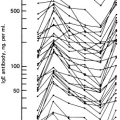Occupational Immunologic Lung Disease
Leslie C. Grammer
Kathleen E. Harris
Occupational asthma (OA) is the most common form of occupational pulmonary disease in developed countries, including the United States (1). Increasing industrialization has led and will likely continue to lead to the production of numerous materials capable of inducing immunologically mediated lung disease in the working population. This is of concern to physicians who diagnose and treat these diseases and to labor, management, and a variety of governmental agencies.
There are two major subdivisions of diseases that constitute occupational immunologic lung disease (OILD): (a) immunologically mediated asthma which is often accompanied by allergic rhinitis and allergic conjunctivitis and (b) hypersensitivity pneumonitis. In addition, there is an asthma syndrome that can occur after high level irritant exposure; this is called reactive airways dysfunction syndrome (RADS) (1). There is also a category of OA entitled “work exacerbated asthma” which has been defined as pre-existing or concurrent asthma that is exacerbated by workplace exposures to such things as cold air, fumes, dusts, or exercise (2). According to the 2007 National Asthma Education and Prevention Program Expert Panel Report 3, asthma should be controlled so that patients can exercise, tolerate cold air, and have normal attendance at school or work, in addition to other activities (3). Therefore, some would assert that work-exacerbated asthma is simply asthma that is not being managed in accordance with Expert Panel Guidelines.
This chapter organizes the various exposures into the most relevant disease category. Various overlaps and uncertainties exist generally in OILD, and in OA, in particular. First, some exposures can cause more than one disease. For instance, some antigens, such as trimellitic anhydride (TMA) and various fungal antigens, can cause more than one immunologic pulmonary disease, including asthma or hypersensitivity pneumonitis (4). Second, many reactive chemicals, such as toluene diisocyanate (TDI), can cause disease by inducing either RADS or immunologic asthma (1). Finally, pulmonary responses to some antigens have not been definitely established as immunologically or nonimmunologically mediated; an example would be Western red cedar.
Epidemiology
Incidence and prevalence figures for OILD are difficult to obtain for several reasons. First, there is often a high turnover rate in jobs associated with OILD, thus selecting workers who have not become sensitized. For instance, there is a high turnover rate among platinum workers. In a study of an electronics industry, a substantial proportion of workers who left reported respiratory disease as the reason (5). Second, occupationally related diseases generally are underreported (6). For instance, although the incidence of work-related illness is thought to be upward of 20 per 100, only 2% of these illnesses were recorded in employers’ logs, as required by the Occupational Safety and Health Administration (OSHA) (7). Finally, the incidence of disease varies with the antigen exposure involved. For example, the incidence of occupational lung disease among animal handlers is estimated at 8% (8), whereas that of workers exposed to proteolytic enzymes can be up to 45% which is significantly higher (9).
It has been estimated that 2% of all cases of asthma in industrialized nations are occupationally related. In U.S. surveys, 9% to 15% of adult asthma cases were classified as occupational in origin (10,11). The European Community Respiratory Health Survey Study Group reported the highest risk for asthma was in farmers (odds ratio, 2.62), painters (2.34), plastic workers (2.20), cleaners (1.97), and spray painters (1.96) (12). In an American study of work-related asthma in California, Massachusetts, Michigan, and New Jersey, the most common industries where OA occurred were transportation manufacturing equipment (19.3%), health services (14.2%), and educational services (8.7%) (13). In other reported studies, health care workers have been noted to have an increased risk for OA (14,15).
Medicolegal Aspects
Most sensitizing agents that have been reported to cause occupational asthma are proteins of plant, animal, or microbial derivation and are, therefore, not specifically regulated by OSHA. Some of the low-molecular-weight sensitizers, such as isocyanates, anhydrides, and platinum, are regulated by OSHA; published standards for airborne exposure can be found in the Code of Federal Regulations (CFR 29.1910.1000) (16). OSHA, a division of the U.S. Department of Labor, is responsible for determining and enforcing these legal standards. The National Institute of Occupational Health and Safety (NIOSH), a division of the U.S. Department of Health and Human Services, is responsible for reviewing available research data on exposure to hazardous agents and providing recommendations to OSHA relative to airborne exposure limits. However, NIOSH has no regulatory or enforcement authority in this regard. More than 200 different substances have been reported to act as respiratory sensitizers and causes of occupational asthma (1). In only a few European countries are such occupational respiratory illnesses recognized by law with rights of compensation. In France, such etiologic agents as isocyanates, biologic enzymes, and tropical wood dusts are recognized. In the United Kingdom, such agents as platinum salts, isocyanates, colophony, and epoxy resins are recognized. It has been reported that in countries where legislation involving compensation exists, implementation may still be difficult because of the lack of explicit criteria for the diagnosis of a given occupational disease (17).
The Hazard Communication Standard, also called “worker right-to-know” legislation at the federal, state, and local levels, was passed in the United States about three decades ago (18). Substances that are capable of inducing respiratory sensitization are generally considered hazardous, and thus workers exposed to such substances are covered in most legislation. The common elements that exist in most hazard communication legislation are (a) that the employer apprise a governmental agency relative to its use of hazardous substances; (b) that the employer inform the employee of the availability of information on hazardous substances to which the employee is exposed; (c) that there be available to the employee alphabetized material safety data sheets for hazardous substances in the workplace; (d) that there be labeling of containers of hazardous substances; and (e) that training be provided to employees relative to health hazards, methods of detection, and protective measures to be used in handling hazardous substances. This sort of hazard communication legislation may make workers more aware of the potential that exists to develop respiratory sensitization and OILD syndromes due to certain exposures. Whether this awareness will have an effect on the incidence of OILD remains to be seen.
Legal and ethical aspects of management of individuals with occupational asthma are major problems (17). Guidelines for assessing impairment and disability from occupational asthma continue to evolve (19,20). The ATS has proposed criteria based on a possible 4 points for each of the following: forced expiratory volume in 1 second (FEV1), methacholine challenge, and medication. After totaling the points, degree of impairment can be determined (20). Depending on the occupation, disability can then be assessed.
Asthma
Pathophysiology
The pathophysiology of asthma is reviewed in Chapter 19. The major pathophysiologic abnormalities of asthma, occupational or otherwise, are bronchoconstriction, excess mucus production, and bronchial wall inflammatory infiltration, including activated T cells, mast cells, and eosinophils (21,22). Neutrophilic occupational asthma has also been described (23). There is evidence that these abnormalities may be at least in part explained by neurogenic mechanisms and release of inflammatory mediators and cytokines such as interleukins and interferons. Type I hypersensitivity involving cross-linking immunoglobulin E (IgE) on the surface of mast cells and basophils, resulting in release of mediators such as histamine and leukotrienes and of cytokines such as interleukin-3 (IL-3), IL-4, and IL-5, is believed to be the triggering mechanism in most types of immediate-onset asthma. There is increasing evidence that cellular mechanisms are very important in asthma (23). An updated paradigm of the Gell and Coombs classification is improving our understanding of some of those cellular mechanisms (24). There are now four types of type IV, or cellular, mechanisms. Type IVa2 involves TH2 cells and is probably responsible for late asthmatic responses.
There are also nonsensitizing causes of occupational asthma (25). RADS was originally described two decades ago by Brooks and Lockey. The criteria for RADS are listed in Table 25.1. Several aspects of RADS are very characteristic (26). First, it results from a very high level of exposure to a toxic substance. Second, the asthma-like condition starts with that exposure. Third, the patient has symptoms that persist for at least 3 months. Finally, because of airway hyperreactivity, the patient develops bronchospasm from a variety of stimuli, including exercise, cold air, fumes, and irritant chemicals such as bleach or ammonia.
Table 25.1 Criteria for Reactive Airways Dysfunction Syndrome (RADS) | |
|---|---|
|
Reaction Patterns
A number of patterns of asthma may occur after a single inhalation challenge, as shown in Table 25.2 (22). The immediate reaction is mediated by IgE, occurs within
minutes of challenge, presents as large airway obstruction, and is preventable with cromolyn and reversible by bronchodilators. The late response occurs several hours after inhalation challenge, presents as small airway obstruction in which wheezing may be mild and cough and dyspnea may predominate, lasts for several hours, is usually preventable with steroids (27) or cromolyn, and is only partly reversed by most bronchodilators. It may well result from a type IVa2 reaction.
minutes of challenge, presents as large airway obstruction, and is preventable with cromolyn and reversible by bronchodilators. The late response occurs several hours after inhalation challenge, presents as small airway obstruction in which wheezing may be mild and cough and dyspnea may predominate, lasts for several hours, is usually preventable with steroids (27) or cromolyn, and is only partly reversed by most bronchodilators. It may well result from a type IVa2 reaction.
Table 25.2 Types of Respiratory Response to Inhalation Challenge | ||||||||||||||||||||||||||||||||
|---|---|---|---|---|---|---|---|---|---|---|---|---|---|---|---|---|---|---|---|---|---|---|---|---|---|---|---|---|---|---|---|---|
| ||||||||||||||||||||||||||||||||
The dual response is a combination of the immediate and late asthmatic responses. It is partially prevented by steroids or bronchodilators. After a single challenge study with certain antigens like Western red cedar, the patient may have repetitive asthmatic responses occurring over several days. This repetitive asthmatic response can be reversed with bronchodilators. Other atypical patterns—square wave, progressive, and progressive and prolonged immediate—have been described after diisocyanate challenges; the mechanisms resulting in these patterns have not been elucidated (28).
Etiologic Agents
Most of the 200 agents that have been described to cause occupational asthma are high-molecular-weight (>1 kDa) heterologous proteins of plant, animal, or microbial origin. Low-molecular-weight chemicals can act as irritants and aggravate preexisting asthma. They may also act as allergens if they are capable of haptenizing autologous proteins in the respiratory tract. Numerous reviews of occupational asthma have information on etiologic agents (1,29,30). A representative list of agents and industries associated with OILD can be found in Table 25.3.
Table 25.3 Examples of Occupational Allergens | |||||||||||||||||||||||||||||||||||||||||||||||||||||||||||||||
|---|---|---|---|---|---|---|---|---|---|---|---|---|---|---|---|---|---|---|---|---|---|---|---|---|---|---|---|---|---|---|---|---|---|---|---|---|---|---|---|---|---|---|---|---|---|---|---|---|---|---|---|---|---|---|---|---|---|---|---|---|---|---|---|
| |||||||||||||||||||||||||||||||||||||||||||||||||||||||||||||||
Etiologic Agents of Animal Origin
Proteolytic enzymes are known to cause asthmatic symptoms on the basis of type I immediate hypersensitivity. Examples are pancreatic enzymes, hog trypsin (31) used in the manufacture of plastic polymer resins, Bacillus subtilis enzymes (32) incorporated into laundry detergents, and subtilisin. Papain, which is a proteolytic enzyme of vegetable origin used in brewing beer and manufacturing meat tenderizer, has been noted to cause similar symptoms by IgE-mediated mechanisms (33). Lactase is another enzyme reported to cause respiratory hypersensitivity; in the same publication, contact dermatitis is also reported (34).
Animal dander can cause asthma in a variety of workers, including veterinarians, laboratory workers, grooms, shepherds, breeders, pet shop owners, farmers, and jockeys (35). This can be a problem even for people whose work takes them to homes of clients who have pets, such as real estate salespeople, interior designers, and domestic workers.
Immediate asthmatic reactions and late interstitial responses have been reported after inhalation challenge with avian proteins in people who raise poultry and in workers exposed to egg products in egg processing facilities (36). Positive skin test results and in vitro IgE have been demonstrated, as well.
A variety of insect scales have been associated with asthma. Occupational exposure to insect scales occurs in numerous circumstances (1,29




Stay updated, free articles. Join our Telegram channel

Full access? Get Clinical Tree








